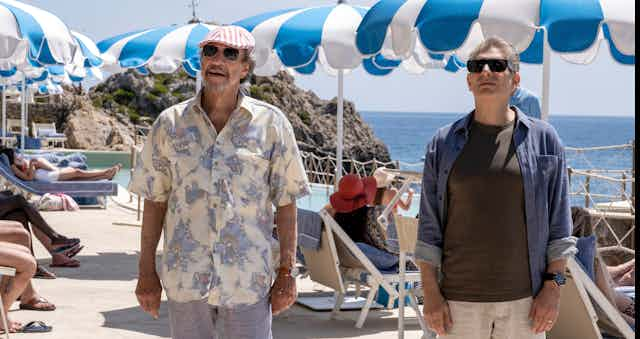The HBO series The White Lotus faced stiff competition when it was launched in summer 2021.
It emerged into a glut of post-pandemic quality television programming, from continuing hit shows like Succession, Ozark and Ted Lasso, and aired the same year as a new crop of startups like Yellowjackets and Only Murders in the Building.
The solid reputation of White Lotus creator, writer and director Mike White (staff writer for Dawson’s Creek, writer of School of Rock and also actor who played Jack Black’s sidekick in the film) was sufficient to attract an audience and elevate excitement about the series amid a crop of shows about rich people acting badly.
When the show’s trailer was released in June 2021, its strikingly novel soundtrack stood out. This could be heard in full on YouTube and Spotify before HBO aired the first episode that July.
This unsettling soundscape of odd rhythms and unusual uses of instruments and voices persisted throughout Season 1 and 2, garnering two 2022 Emmy awards and a current Emmy nomination for Chilean-born Canadian composer Cristobal Tapia de Veer, who wrote the original score.
Primetime Emmy Awards 2023 were originally scheduled to take place in September, but are now re-scheduled to January 2024 due to the ongoing actors’ and writers’ strikes.
Canadian composers in film and TV
Tapia de Veer joins Emmy-winning Canadian composers Christophe Beck and Mychael Danna, demonstrating the important role Canada has occupied in producing music for film and television.

Tapia de Veer studied classical music in Québec, and then performed popular music with his band OneTon. In the early 2000s, he had a Canadian hit with the song “Supersex World,” but then turned to working on music for film and television, creating scores for series like Hunters, Humans and Utopia.
In addition to Emmy nominations, Tapia de Veer’s creations have garnered him two Prix Gémeaux for best theme and best original music for the ICI Radio-Canada Télé show Série noire (2014, 2016). The Society of Composers, Authors and Music Publishers of Canada (SOCAN) has honoured him multiple times, including in 2017 and 2021, and most recently in spring 2023 with the Outstanding Screen Composer Award.
‘Haunting’ sounds
Tapia de Veer’s work for The White Lotus has brought him a global notoriety: NPR described the show’s soundtrack as keeping fans talking and haunting people’s lives. The composer told Variety White “wanted the music to feel like it was boiling under these characters.”
By Tapia de Veer’s admission, the theme “Aloha” provided the show’s Season 1 audience with a sonic foretaste of “the wild stuff coming for the characters,” as he notes in an interview with Spotify.

In doing so, Tapia de Veer presents the themes and sounds that dominate the six Season 1 episodes. His characteristic blurring of the boundaries between music and sound design is clearly displayed here. The “Aloha” theme combines vocal and percussive sounds the composer calls “tribal” and “primal,” with bird calls “for an island feel with a spooky tropical depth.”
Menacing undertone
This unsettling soundscape persists throughout the season. It provides a menacing undertone to a surface layer of popular music that tourists to Hawaii may recognize, whether it’s Louis Armstrong singing “On a Coconut Island” or the Rose Ensemble performing “Aloha ‘Oe,” a traditional Hawaiian song composed by Queen Liliʻuokalani.
The White Lotus “Aloha” theme is no Hawaii Five-0 evocation of island culture! For example, when Tapia de Veer uses the human voice in the underscore, it is never with words but rather in bizarre vocalizations.
These disturb listeners through their uncanniness, reflecting the characters’ flawed underlying motives and emotional dysfunction.
‘Renaissance’ set in Italy
If the first season stresses rhythmic elements, the show’s Season 2 relocation to Sicily brings out the more traditionally melodic side of Tapia de Veer’s creativity. Season 2’s main theme, “Renaissance,” features flowing piano, harp and (wordless) operatic voice. These establish the season’s European setting. In later episodes, this setting is localized by the use of the mandolin, an Italian folk instrument.
However, “Renaissance” soon connects with the first season by reprising the “Aloha” theme and then adding tension through synth filtering and a techno beat. Again, Tapia de Veer’s dark and disturbing scoring undermines the surface elegance and politezza reinforced by songs like Raffaella Carrà’s “A Far l’Amore Comincia Tu” for the arrivals, or Alan Sorrenti’s “Figli Delle Stelle” for the threesome in Episode 2.
Disconcerting background tones

Stories of treachery and infidelity play out in the disconcerting background tones created by Tapia de Veer and longtime collaborator Kim Neundorf, who in Season 2 has contributed to or composed over 10 tracks. Neundorf also worked with Tapia de Veer on the TV series Humans and The Third Day, as well as the horror film Smile.
In The White Lotus Season 2, these tracks stand in contrast to songs evoking stereotypical love and seduction fantasies performed by one of the local characters, a singer. The initially naïve Mia performs multiple times during the season, most notably “That’s Amore” for the guests in Episode 5 and — in a lesbian seduction scene — a rendition of “Happy Birthday” reminiscent of Marilyn Monroe in Episode 6. Tapia de Veer and Neundorf effectively subvert our expectations of well-known songs by placing them in the context of the disturbing musical soundscapes.
Next season: 36 Thai gongs
It will be interesting to hear what White and Tapia de Veer decide to serve up as the music for the next ‘White Lotus’ season in Thailand.
Already, the composer has teased his inclination for including the sounds of Buddhist temples and for using his collection of 36 Thai gongs “to go deep with it [and] make it take a journey.”

